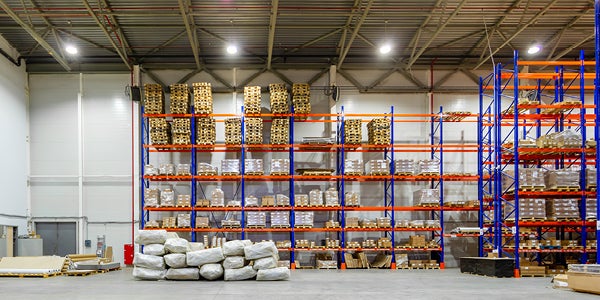When it comes to supply chain sourcing, the goal is to move products as quickly and efficiently as possible. Reevaluating current supply chain trends creates a domino effect for business owners. They'll need to adjust cash flow, cash reserves, and their overall balance sheet to accommodate increased fees
Jump To...
The eCommerce Boom | The Great Resignation | The Trucking Industry | Supply Chain Risk Categories | Supply Chain Mapping | Risk Rating System | Capacity Buffers & Safety Stock | Supplier Diversification | China+1 | Focus Local | Automation Advancements | Continuous Flow Manufacturing
The Covid-19 pandemic and ensuing supply chain crisis has rippled across global business. Energy prices rise daily, and shipping costs seem to break new records with every voyage. Supply chain sourcing for mid-sized companies is more important than ever, as the coming years force businesses to rethink and re-strategize their supply chains. As the business world adapts to the "new normal," cash-flow management and accurate forecasting hold the keys to success.
The supply chain was bending well before Covid officially broke it. Trend-savvy business leaders felt prepared, but sudden global lockdowns ground everything to a halt. Demand fell off a cliff, only to then be airlifted to never-before-seen heights by federal stimulus. To put the boom in perspective, rising demand between 2020 and 2022 was equivalent to 50 million new Americans joining the economy.
The ensuing eCommerce Boom forced understaffed, off-shore manufacturers into overdrive. Now in 2022 the supply chain is still attempting to catch up. From new Covid variants to a freighter lodged in the Suez Canal, a wide range of incidents have forced supply chain experts to take two steps forward, and one and a half steps back.
Just-in-time manufacturing practices took the brunt of the scrutiny when hospitals experienced shortages in necessary personal protective equipment (PPE). Meanwhile, computer chip shortages derailed the launch of next-gen video game consoles and automobiles. How can major corporations be better prepared for projected continued supply chain struggles?
The Current State and Future of The Supply Chain
Experts continue extending their projections for a supply chain stabilization timeline. As it stands, the most significant concerns among industry insiders and business leaders are shipping costs, lead times, manufacturing shortages, and labor shortages.
As vaccines become more widely available, those labor shortages will likely ease. However, The Great Resignation stands in the way, as record numbers of Americans quit their jobs searching for better wages and working conditions.
Shipping lines and logistics companies account for 90% of world trade, and the cost of utilizing their services has gone up thirteenfold since pre-pandemic levels. In October, The New York Times reported shipping costs as high as $25,000/container. These price hikes amplify the importance of proper cash-flow management as shipping costs continue eating away at profits.

Meanwhile, the trucking industry experienced a shortage of 80,000 drivers, a 30% increase from pre-pandemic levels. Freighters sit anchored off the coast of Southern California 2.5 times longer than they did before. Even though production at the ports is up 50%, there aren't enough truck drivers to transport cargo on time. According to Chris Spear, president and CEO of the American Trucking Association, inaction could see the need for 1,000,000 new drivers over the next ten years.
These factors—among many others—play a significant role in increased lead times. When it comes to supply chain sourcing, the goal is to move products as quickly and efficiently as possible. Reevaluating current supply chain trends creates a domino effect for business owners. They'll need to adjust cash flow, cash reserves, and their overall balance sheet to accommodate increased fees.
Those fees may come in the form of expanded warehouse space (which has itself become a commodity amid the crisis), increased shipping and labor costs, and dealings with multiple suppliers, rather than one bulk supplier. Supply chain management and cash flow go hand in hand. So how can business leaders uncover and lessen risk when supply chain sourcing?
Evaluate Your Current Supply Chain Management Strategy to Uncover Risks
Risk management is the key to surviving the business world, but industry leaders can take further steps to uncover hidden risks within their supply chain. Before the pandemic, supply chain management didn’t always get the attention it deserved. However, everything ran smoothly—for the most part—and aside from a natural disaster here and there, companies smoothed supply chain risk without breaking a sweat.
Then came Covid.
Jim Yarbrough, a global intelligence program manager for BSI Group, has spoken about Covid bringing supply chain concerns to the forefront. "The supply chain must be secure and resilient, and we need alternate suppliers; we need alternate routes," he says.

His sentiment focuses on maintaining inventory—one of the identified shortcomings of just-in-time manufacturing. New businesses can't grow without inventory to sell. According to the Federal Reserve, 200,000 businesses closed their doors because of pandemic-induced shortages. Large enterprises with more cash reserves always had a fighting chance.
Supply chain risks boil down to four main categories:
- Economic risks: supplier bankruptcy, work stoppages, recessions
- Environmental risks: natural disasters (or, in this case, a global pandemic)
- Ethics risks: sourcing materials from child/forced labor or unsafe work environments
- Political risks: Civil unrest within a nation, or new tariffs, sanctions, and restrictions on imports/exports
We can only hope for the Covid pandemic to subside within the year. However, data from EM-DAT, an international disaster database, shows the frequency of natural disasters has slowly increased over the past 20 years. There've also been trending upticks in consumer awareness. End-users want to know that their products come from ethical and sustainable resources. They're less likely to buy from a company that sources materials from a supplier who dumps waste into the ocean.
While smaller industries need only worry about their tier 1 suppliers, larger corporations must look further down the supply chain: their supplier, their supplier's supplier, and so on, all the way down to raw material sources. But what happens when the raw material manufacturer shuts down unexpectedly?
Companies must identify risks among all their partners. According to Joe Sarkis, a supply chain management professor at Worcester Polytech, "If the network comes down to one supplier deep in the supply chain, and that supplier goes down, or that one arc or node goes down, the whole thing falls apart."
Supply chain mapping is one of the most effective ways to weed out risk in your supply chain. In collaboration with your colleagues, you can build a supply chain map to establish who your suppliers are, what they provide, and where they're shipping from. Teamwork between colleagues ensures that no supplier will be overlooked, as one kink in the chain, as Sarkis put it, can derail the entire system. Once established, the supply chain map is relatively easy to update as you add and drop supply partners.
Aside from mapping, business leaders can employ a few other sourcing strategies to make their supply chain more resilient. For example, a ranking system assigns weighted importance to various risk factors, such as financial independence, credit history, economic/political disruption, and natural disasters.

In this system, each factor receives weighted importance, with the supplier scoring 1-5 (five being the highest) in each category. By calculating the weighted average of those scores, you determine a score representative of the supplier's risk. You can then compare those scores with other suppliers.
The Association of Supply Chain Management (ASCM) takes weighted importance to a new level with their Value at Risk (VaR) metric. ASCM uses the VaR metric to compare risk associated with various suppliers to the potential for loss. Let's say there's a 5% chance of an earthquake shutting down one of your west coast manufacturers, and the value of product affected would equal $2 million. The VaR would be 0.05 x $2 million, which equals $100,000. You may carry enough inventory to prevent that $100,000 loss should an earthquake occur based on those numbers.
Create Capacity Buffers and Safety Stocks
Many use the terms 'capacity buffers / buffer stock' and 'safety stock' interchangeably. Yes, both refer to keeping extra resources on hand to account for issues with suppliers and manufacturers. However, one is tailored to raw material while the other pertains to the finished product. The difference has to do with the end-user in both circumstances. Ultimately, both are viable strategies for supply chain sourcing.
Buffer stock refers to keeping ample finished products on hand to combat spikes in consumer demand. Business leaders can use analytics and year-over-year trends to determine when to expect peaks and valleys in demand for their products. Let's say your company is an industry leader in camp chairs and supplies. You probably sell ample camp chairs year-round, as warmer climates drive purchases for full-time outdoor enthusiasts. However, sometime in May, you might ramp up production, anticipating a spike in demand from adventurers hitting the parks and trails. Buffer stock ensures that a particularly busy summer won't deplete your shelves. While you expected a good summer, you don't want to be blindsided by unforeseen spikes in demand.
Safety stock has to do with raw material, making you (and your camp chair company) the end-users of the cloth, wood, paint, metals, and cup holders that come with your product. Companies may be inclined to fortify their safety stocks in the current supply chain climate, ensuring they meet sales expectations for the busy season. This means ordering early, ordering in bulk, and diversifying your suppliers for the most efficient influx of raw material.
Both strategies help combat supply chain issues and unforeseen market fluctuations. Forecasting is never 100% accurate, and customers who can't get the products they expect may go to the competition.
Diversify Your Supply Base
Just like you should diversify your portfolio, you should also diversify your suppliers. Having backup options when supply chain sourcing gives your company someone to fall back on should your primary supplier experience shortages or delays.
Supplier diversification is useful for lessening supply chain risks, and perhaps the best way to hedge your supply chain against risk. So how can industry-leading companies diversify their supply chain to combat today's shipping shortages?

Step 1: Examine the Situation
To begin, you're looking to understand two crucial factors: the market and your product. What raw materials do you need? What specifications does your product need to meet? Can you substitute one component out for another, or do you require specific resources from specific suppliers? While those are the two extremes, your product probably falls somewhere in the middle.
Once you've established your product needs, examining the current market can reveal plenty of helpful information. You'll gain a better understanding of customer concerns and capacity constraints. Furthermore, you'll see how supply chain delays, tariffs, and fluctuating prices affect the market.
Step 2: Strategize
Once you've learned everything you can about the product and market, it's time to build a strategy around diversifying your supply chain. If done correctly, the diversification plan should reveal itself.
For example, if you determine that a particular raw material can be substituted without altering the final product, you may decide to keep that supplier in your back pocket in case something happens to your primary source. To develop a strong diversification strategy, ask yourself the following questions:
- What roadblocks could disrupt the supply chain? Natural disasters? Political regulations?
- Who are my primary suppliers?
- How long are the longest lead times?
- What are the most specific / unique components of this product?
Answering those questions makes it easier to set and achieve goals safeguarding your supply chain. It could be as simple as securing three different suppliers for one product: one primary and two back-ups. You could even strive to produce more volatile resources (those most susceptible to supply chain issues) on-site. On-site manufacturing, while often a large undertaking, could save you money in the future, so consult with a trusted financial partner to analyze the initial capital investment required for the necessary fixed assets and the potential rate of return.
Step 3: Identify, Narrow, and Select Suppliers
With your goals in mind, it's time to list suppliers that might suit your needs. For example, if you're looking for more nearshore suppliers to balance out the cost of shipping overseas (which we'll cover later), look for suppliers in neighboring countries or states.
Once you've narrowed that list, it's time to select which suppliers work best in your diversification strategy. Who's offering the best prices? Lead times? Contracts? Which of these companies is less susceptible to supply chain risk via VaR calculations?
Diversification strategies have been commonplace long before Covid, but the pandemic has since exacerbated the need for alternate suppliers. For example, many companies that relied primarily on China shifted to a "China +1" strategy for supply chain diversification. In the wake of the U.S.-China trade war, "China+1" saw many companies sourcing supplies from other Southeast Asian countries like Indonesia, Thailand, and Vietnam.
Consider Local Sourcing and Nearshoring
Natural disasters sit atop any supply chain expert's list of significant risks. When speaking on the 2011 earthquake that rattled Japan and Toyota, Dave Alberts, director of Crimson & Co., a leader in end-to-end supply chain consulting, said, "Clearly there are disadvantages to sourcing products from countries that suffer from extreme weather conditions, especially when supply is so geographically focused."
A vast majority of companies are susceptible to these disadvantages. In the U.K. alone, the average manufacturer deals with around 190 suppliers. Almost 100% of those manufacturers import their supplies from overseas.
One of the best ways to combat supply chain issues from overseas suppliers is to bring the raw material closer to home. Local and nearshore supply chain sourcing lowers the risk (and cost) of importing materials across the ocean.

According to a 2012 report from the Manufacturers' Organization, two-fifths of 150 respondents brought production back in-house in response to supply chain volatility. Today, the same strategies apply in the wake of Covid-influenced supply chain issues.
In-house production, however, requires an immense amount of available cash flow, and may only be attainable by larger companies. Small and mid-sized companies can instead turn to local and nearshore suppliers to lower supply chain risk without eating into available cash reserves. Doing so comes with a number of benefits such as increased security, control, flexibility, simplicity, and—ultimately—revenue.
Control and Flexibility
Local suppliers give you significantly more leeway when, for example, an existing client decides to ramp up demand. Local suppliers are typically more responsive than overseas suppliers. Products arrive faster, and shipment coordination streamlines moving across state lines rather than expansive open oceans.
Since your supply chain is closer to home, you have significantly more control over it. How often can you pop into a supplier halfway around the world? Maybe once per year? Ensure your company remains a priority by setting up regular meetings with local suppliers. In-person visits also maintain lines of communication, as fewer requests get lost in translation—both figuratively and literally.
Reduced Logistics Expenses Equals More Revenue
Every year, North American companies spend over $1 trillion on logistics. In 2021 alone, the US spent $1.56 trillion on logistics, down 4% from 2020. However, those numbers are currently trending upward.
If you're looking to trim your budget, consider tightening your supply chain. Local suppliers eliminate the need for cross-ocean and cross-country shipping. Furthermore, the closer they are to home, the less you'll spend on storage and warehouse space.
While on the subject, warehouse space has become a commodity in modern times. The pandemic triggered a "firestorm" in demand for warehouse space. However, delayed construction times paired with ongoing supply chain issues made meeting those demands more challenging than ever. As it stands, experts believe the current commercial real estate backlog could take 18-24 months to clear. With rent for available space only increasing, manufacturers must weigh the heightened storage costs against potential sales.
Less money spent on logistics means more money bolstering your bottom line. However, local sourcing also attracts new customers who appreciate your tight-knit supply chain. Many customers are attracted to anything labeled "locally sourced." Furthermore, trimming transportation equals less environmental impact from your production line and supply chain.
Explore Innovations in Technology and Management
While Covid-19 slowed the global supply chain network to a near-screeching halt, it proved no match for human ingenuity. Advancements in technology—including AI supply chain management, automation, and continuous flow manufacturing—now play a significant role in modern supply chain sourcing. Companies can lower their overhead and flexibly alternate between products with new and emerging tech.

Those who stay on top of evolving tech trends maintain a full-step advantage over competitors relying on obsolete methods.
For example, advancements in automation continue to increase productivity exponentially year after year. With the cost of automation falling, manufacturers can rely on robots to keep up with growing product demand. Robots don't need to socially distance themselves, so the pandemic made them more attractive for many manufacturers. These trends made off-shore production in higher-cost countries more practical, as automation bolstered productivity. Furthermore, robotic palletizers and quality control inspections cut the need for human labor when preparing products for shipping.
Continuous Flow Manufacturing(CFM) also optimizes supply chain processes for success with as little inventory as possible. Similar to just-in-time manufacturing, CFM keeps the product on one production line and oversees the completion of that project from start to finish. CFM cuts waiting, storage, and transportation factors out of the supply chain and instead focuses more on the product and transactional process.
With advancements in 3D printing, manufacturers can cut out the middle man when making complex shapes. They can also produce a wide array of items in higher quantities without relying on distant suppliers. These are just a few examples of the many innovations companies can employ to more efficiently shape their supply chains!
Secure Your Company’s Future in an Uncertain World With a Trusted Financial Partner
With so much to consider when planning sourcing for your supply chain, having a reliable financial partner like First Bank & Trust, a division of HTLF Bank is more important than ever.
Managing supply chain risk and implementing new technologies requires available cash flow. With experts predicting continued supply chain sourcing issues through 2022 and possibly 2023, companies must be ready to pivot to maintain consistent profits. Get in touch with a commercial banker with deep industry insight at First Bank & Trust, a division of HTLF Bank to explore options to maximize cash flow and grow your business today and in the future.










